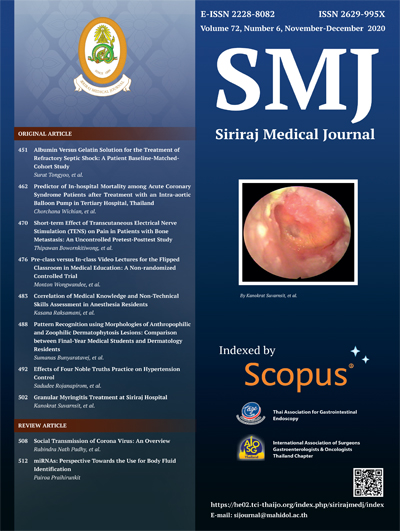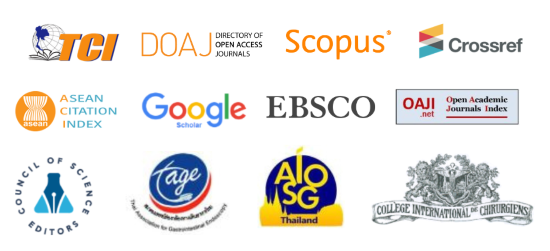Pattern Recognition using Morphologies of Anthropophilic and Zoophilic Dermatophytosis Lesions: Comparison between Final-Year Medical Students and Dermatology Residents
DOI:
https://doi.org/10.33192/Smj.2020.66Keywords:
morphological diagnosis, anthropophilic dermatophytosis, zoophilic dermatophytosis, accuracy, medical students, dermatology residentsAbstract
Objective: To compared pattern recognition abilities of final-year medical students and dermatology residents to distinguish and classify superficial fungal infections and resembling lesions.
Methods: The study was conducted at the Department of Dermatology, Faculty of Medicine, Siriraj Hospital, Mahidol University, Bangkok, Thailand, in 2019. The participants had to make diagnosis from 78 images including typical and atypical lesions within 50 second. No history or any description was given. The answer sheets were reviewed.
Results: Medical students (n = 18) and dermatology residents (n = 19) showed no significant differences in the means of overall accuracy scores. Residents demonstrated a statistically higher mean score than the medical students in diagnoses of anthropophilic infection with mostly presented with typical lesion. However, there were no significant differences in the mean scores for their diagnoses of zoophilic dermatophytosis as atypical lesions and other skin lesions.
Conclusion: Pattern recognition was helpful for the diagnosis of cutaneous dermatophytosis, especially in cases of typical lesions. Nonetheless, pattern recognition alone is insufficient for the diagnosis of atypical dermatophytosis lesions: analytical diagnostic skills should also be enhanced to an increase in the accuracies of atypical-lesion diagnoses.
References
2. Hassanzadeh Rad B, Hashemi SJ, Farasatinasab M, Atighi J. Epidemiological Survey of Human Dermatophytosis due to Zoophilic Species in Tehran, Iran. Iran J Public Health 2018;47:1930-6.
3. Kaushik N, Pujalte GG, Reese ST. Superficial Fungal Infections. Prim Care 2015;42:501-16.
4. Weitzman I, Summerbell RC. The dermatophytes. Clin Microbiol Rev 1995;8:240-59.
5. Hainer BL. Dermatophyte infections. Am Fam Physician 2003;67:101-8.
6. Costa Filho GB, Moura AS, Brandao PR, Schmidt HG, Mamede S. Effects of deliberate reflection on diagnostic accuracy, confidence and diagnostic calibration in dermatology. Perspect Med Educ 2019;8:230-6.
7. Norman GR, Rosenthal D, Brooks LR, Allen SW, Muzzin LJ. The development of expertise in dermatology. Arch Dermatol 1989;125:1063-8.
8. Landefeld CS, Chren MM, Myers A, Geller R, Robbins S, Goldman L. Diagnostic yield of the autopsy in a university hospital and a community hospital. N Engl J Med 1988;318:1249-54.
Downloads
Published
How to Cite
Issue
Section
License
Users are free to share, copy, and redistribute all articles published in the Siriraj Medical Journal (SMJ) in any medium or format as long as you follow the following terms:
- Attribution — You must give appropriate credit, provide a link to the material, and indicate if changes were made. You may do so in any reasonable manner, but not in any way that suggests the publisher endorses you or your use.
- NonCommercial — You may not use the material for commercial purposes.
- NoDerivatives — If you remix, transform, or build upon the material, you may not distribute the modified material.
- No additional restrictions — You may not apply legal terms or technological measures that legally restrict others from doing anything the license permits.











